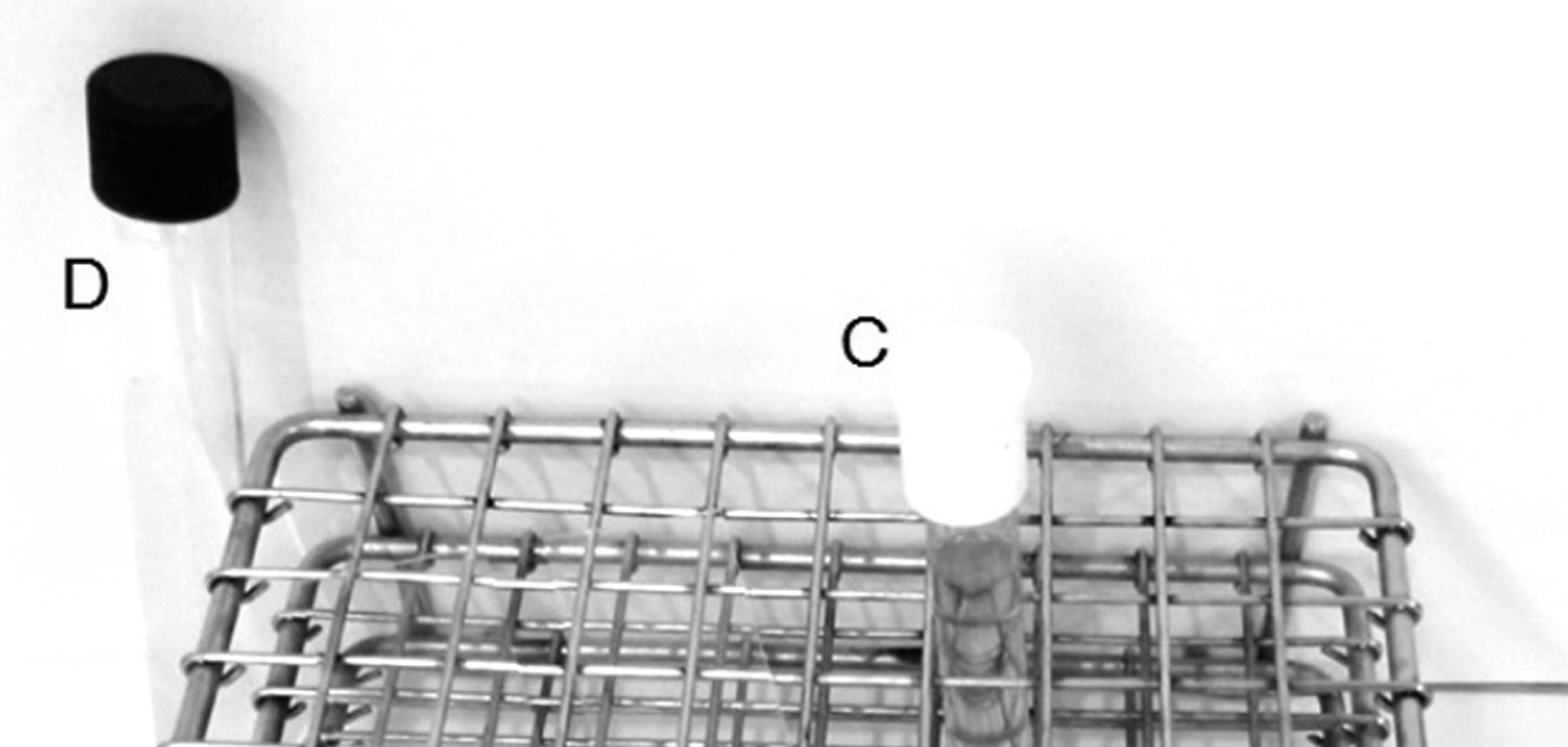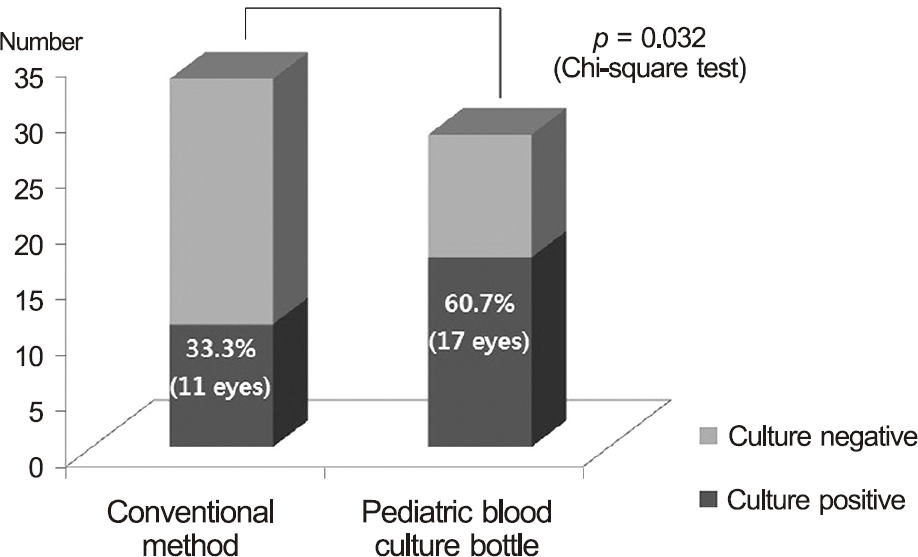Abstract
Purpose
To investigate the effectiveness of the pediatric blood culture bottle for vitreous sample culture in endophthalmitis patients.
Methods
All consecutive cases with clinically suspected endophthalmitis treated and cultured in our institution between January 2009 and June 2013 were included in the study. Vitreous samples were obtained by vitreous needle aspiration (tap), anterior chamber aspiration, or mechanized vitreous biopsy (vitrectomy). The samples obtained using the conventional method until August 2011 were classified as group I. Since August 2011, the BacT/Alert PF pediatric blood culture bottle (bioMérieux, Marcy l’Etoile, France) was used for culture in group II. We investigated age, gender, biopsy method, cause of infection, use of anti-biotics, bacterial culture, and culture positive rate.
Results
Thirty-three cases were included in group I and 17 cases in group II. There was no significant difference in age, gender, sampling technique, cause of infection, and use of antibiotics between the 2 groups. The culture positive rate in group II (60.7%) was significantly higher than group I (33.3%, p = 0.032). In group II, Enterococcus feacalis was the most common pathogen (8 eyes). In group I, Streptococcus pneumoniae and Pseudomonas aeruginosa were confirmed in 3 cases.
Conclusions
The pediatric blood culture bottle can be used successfully in the examination of clinically suspected endophthalmitis. The method showed higher culture positive rate compared with the conventional method. This technique is simple and maintain-ing a supply of fresh agar media is not necessary.
Go to : 
References
1. Durand ML. Endophthalmitis. Clin Microbiol Infect. 2013; 19:227–34.
2. Kratz A, Levy J, Belfair N. . Broth culture yield vs traditional approach in the work-up of endophthalmitis. Am J Ophthalmol. 2006; 141:1022–6.

3. Javitt JC, Vitale S, Canner JK. . National outcomes of cataract extraction. Endophthalmitis following inpatient surgery. Arch Ophthalmol. 1991; 109:1085–9.
4. Powe NR, Schein OD, Gieser SC. . Synthesis of the literature on visual acuity and complications following cataract extraction with intraocular lens implantation. Cataract Patient Outcome Research Team. Arch Ophthalmol. 1994; 112:239–52.
5. Kattan HM, Flynn HW Jr, Pflugfelder SC. . Nosocomial en-dophthalmitis survey. Current incidence of infection after intra-ocular surgery. Ophthalmology. 1991; 98:227–38.
7. Thompson WS, Rubsamen PE, Flynn HW Jr. . Endophthalmitis after penetrating trauma. Risk factors and visual acuity outcomes. Ophthalmology. 1995; 102:1696–701.
8. Jackson TL, Eykyn SJ, Graham EM, Stanford MR. Endogenous bacterial endophthalmitis: a 17-year prospective series and review of 267 reported cases. Surv Ophthalmol. 2003; 48:403–23.

9. Donahue SP, Kowalski RP, Jewart BH, Friberg TR. Vitreous cul-tures in suspected endophthalmitis. Biopsy or vitrectomy? Ophthalmology. 1993; 100:452–5.

10. Han DP, Wisniewski SR, Kelsey SF. . Microbiologic yields and complication rates of vitreous needle aspiration versus mechanized vitreous biopsy in the Endophthalmitis Vitrectomy Study. Retina. 1999; 19:98–102.

11. Sharma S, Jalali S, Adiraju MV. . Sensitivity and predictability of vitreous cytology, biopsy, and membrane filter culture in endophthalmitis. Retina. 1996; 16:525–9.

12. Lertsumitkul S, Myers PC, O’Rourke MT, Chandra J. Endophthalmitis in the western Sydney region: a case-control study. Clin Experiment Ophthalmol. 2001; 29:400–5.

13. Yospaiboon Y, Saree S, Pasadhika S. Blood culture and conven-tional media for vitreous culture in infectious endophthalmitis. J Med Assoc Thai. 2005; 88:639–42.
14. Joondeph BC, Flynn HW Jr, Miller D, Joondeph HC. A new culture method for infectious endophthalmitis. Arch Ophthalmol. 1989; 107:1334–7.

15. Kang KT, Kim KS, Kim YC. Factors affecting final visual acuity in infectious endophthalmitis following cataract surgery. J Korean Ophthalmol Soc. 2013; 54:1025–31.

16. Results of the Endophthalmitis Vitrectomy Study. A randomized trial of immediate vitrectomy and of intravenous antibiotics for the treatment of postoperative bacterial endophthalmitis. Endophthalmitis Vitrectomy Study Group. Arch Ophthalmol. 1995; 113:1479–96.
17. Lee NE, Park JM. Clinical results of bacterial endophthalmitis: bacterial culture and visual acuity outcomes. J Korean Ophthalmol Soc. 2011; 52:1173–81.

18. Kratz A, Levy J, Klemperer I, Lifshitz T. Broth cultures yield vs traditional approach in the workup of infectious keratitis. Eye (Lond). 2006; 20:215–20.

19. Spaargaren J, van Boven CP, Voorn GP. Effectiveness of resins in neutralizing antibiotic activities in bactec plus Aerobic/F culture medium. J Clin Microbiol. 1998; 36:3731–3.

20. Rohner P, Pepey B, Auckenthaler R. Advantage of combining resin with lytic BACTEC blood culture media. J Clin Microbiol. 1997; 35:2634–8.

21. Mirrett S, Everts RJ, Reller LB. Controlled comparison of original vented aerobic fan medium with new nonvented BacT/ALERT FA medium for culturing blood. J Clin Microbiol. 2001; 39:2098–101.

22. Wilson ML, Mirrett S, Meredith FT. . Controlled clinical com-parison of BACTEC plus anaerobic/F to standard anaerobic/F as the anaerobic companion bottle to plus aerobic/F medium for cul-turing blood from adults. J Clin Microbiol. 2001; 39:983–9.

23. Weinstein MP, Towns ML, Quartey SM. . The clinical sig-nificance of positive blood cultures in the 1990s: a prospective comprehensive evaluation of the microbiology, epidemiology, and outcome of bacteremia and fungemia in adults. Clin Infect. 1997; 24:584–602.

24. Park SH, Shim H, Yoon NS, Kim MN. Clinical relevance of time-to-positivity in BACTEC9240 blood culture system. Korean J Lab Med. 2010; 30:276–83.

Go to : 
 | Figure 1.Conventional culture media. Blood agar plate (A), chocolate agar (B), thioglycollate broth (C), sabouraud dex-trose agar (D), and slide glasses for Gram stain and KOH test (E). |
 | Figure 2.BacT/Alert® PF (bioMérieux, Marcy l’Etoile, France). A widely used broth culture medium for blood and other body fluids in pediatric practice. It is suitable for bacteria as well as fungi. |
 | Figure 3.Culture positive rate between two groups. Graphs shows that culture positive rate of pediatric blood culture bot-tle group is higher than that of conventional method group ( p = 0.032). |
Table 1.
Baseline characteristics of this study between the conventional method group and pediatric blood culture bottle method group
| Conventional method | Pediatric blood culture bottle | p-value | |
|---|---|---|---|
| Period | January 2009 to August 2011 | August 2011 to June 2013 | |
| Number (n, %) | 33 (54.1) | 28 (45.9) | |
| Sex (male/female) | 13/20 | 11/17 | 0.601* |
| Age (years) | 65.6 ± 14.1 | 70.4 ± 11.0 | 0.153† |
| Sampling technique | 0.082∗ | ||
| Vitrectomy (n, %) | 17 (51.5) | 22 (78.6) | |
| Vitreous and anterior chamber tapping (n, %) | 16 (48.5) | 6 (21.4) | |
| Cause of endophthalmitis | 0.317‡ | ||
| Postoperative (n, %) | 23 (69.7) | 17 (60.7) | |
| Trauma (n, %) | 6 (18.2) | 2 (7.1) | |
| Endogenous (n, %) | 4 (12.1) | 9 (32.1) |
Table 2.
Frequency of organism according to the result of culture




 PDF
PDF ePub
ePub Citation
Citation Print
Print


 XML Download
XML Download